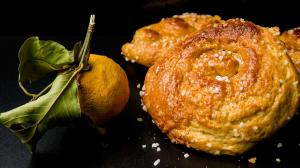ingredients
dough :
- 500 grams (3 ¾ cups) white bread flour - divided into 350 grams (2 ¾ cups) + 125 grams (1 cup) + 25 grams (3 tbsp) for flouring & sprinkling
- 50 grams (½ cup) very finely ground almond powder
- 10 grams (2 ½ tsp) dried instant yeast
- 2 grams (½ tsp) baking powder
- 1-2 grams (¼ - ½ tsp) fine salt
- 180 ml (¾ cup) milk
- 60 ml (¼ cup) fresh orange juice
- 2 grams (1 tsp) orange zest
- 2 grams (1 tsp) ground mahlepi (or use ½ tsp almond extract)
- 5 ml (1 tsp) vanilla extract or 1 split vanilla pod
- 10 ml (2 tsp) orange blossom water
- 0,5 gram or 4 whole cloves (or 1/8 tsp ground clove powder)
- optional : 2 grams (1 tsp) mastic gum resin (ground to a fine powder)
- 125 grams (2 large) eggs
- 125 grams (2/3 cup) granulated sugar
- 125 grams (½ cup) soft butter
'dulce de leche' milk caramel filling :
- 200 grams ‘dulce de leche’ milk caramel spread (or make your own with 400 grams or 1 can sweetened condensed milk but only use half of it or ½ cup after boiling & thickening the whole thing)
- 30 ml (2 tbsp) cointreau (or cognac flavored with 4-5 drops of aromatic orange bitters)
- *or for no dulce de leche caramel filling : just use approximately 47 grams (3 tbsp) very soft butter + 48 grams (4 tbsp) golden cane sugar
finishing garnish :
- egg-milk wash : 1 egg yolk ( 19 grams) + 1 ½ tbsp (22 ml) milk
- 15 grams (1-2 tbsp) rock sugar
- optional : add 2-3 tbsp flaked almonds

















